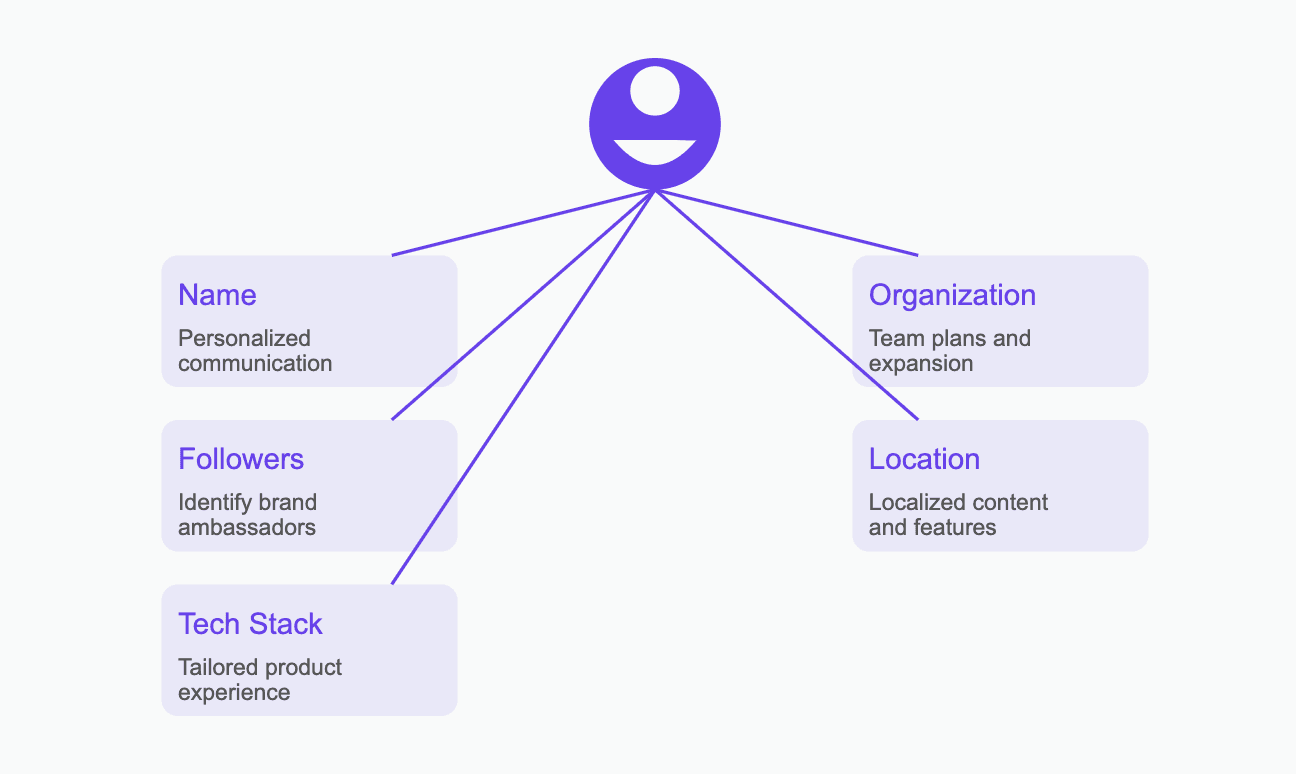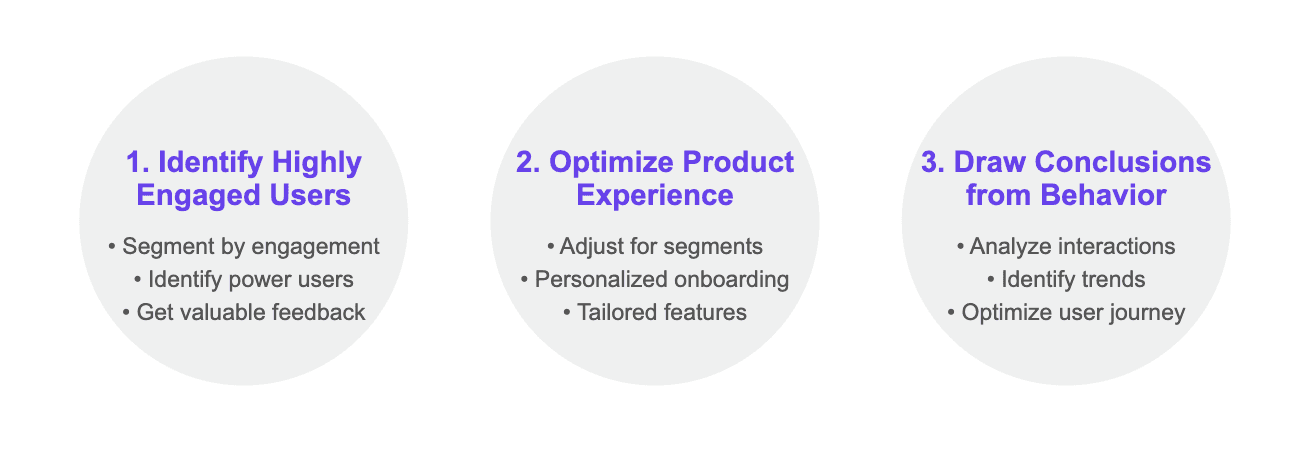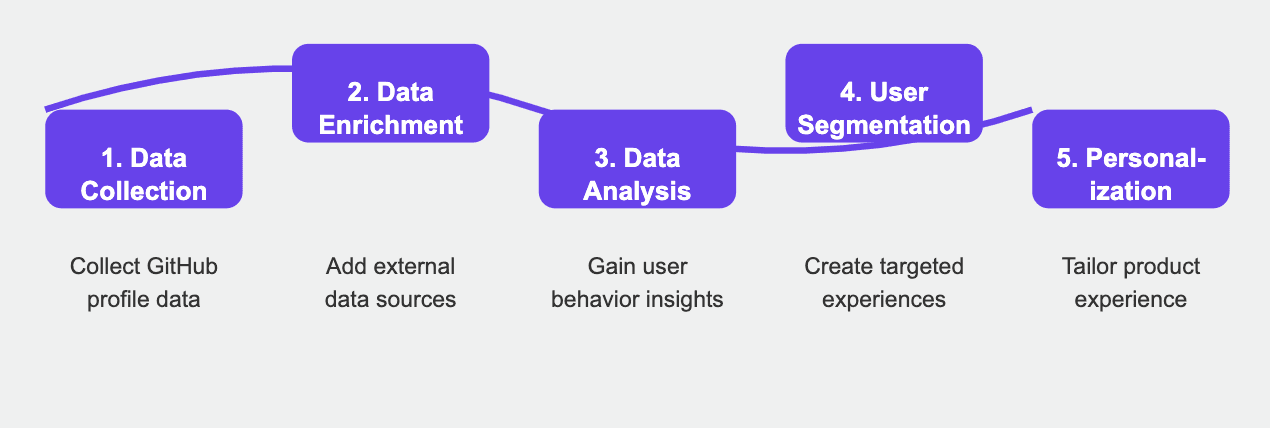
GitHub SSO: Enhancing Dev Tools with Data Enrichment

par
Aleksa Mitrovic
2 oct. 2024
Identifiez et convertissez vos utilisateurs les plus importants
Créer un compte
The majority of developer tools offer users the convenience of signing up using GitHub Single Sign-On (SSO). This integration, while often underutilized, holds immense potential for enriching user data and enhancing the overall user experience.
By leveraging GitHub SSO, developer tools can gather a wealth of information about their users, which can be instrumental in personalizing interactions, optimizing product onboarding, and identifying key influencers within the developer community.
Now, let's delve into the intricacies of GitHub SSO, the power of data enrichment, and the practical applications that can transform the way developer tools engage with their users.

The Potential of GitHub SSO
Here's what makes GitHub SSO so powerful:
GitHub SSO allows developer tools to collect the profile handles of every user who signs up. This information is typically underutilized, but with data enrichment, it can become a powerful asset.
Data enrichment involves augmenting the basic profile information with additional data points that provide a more comprehensive understanding of each user. This enriched data can be used to create personalized experiences, optimize product features, and drive user engagement.
Personalized User Profiles

Let's explore how data enrichment can create detailed user profiles:
Through data enrichment, developer tools can gather detailed information about each user's profile. This includes:
First and Last Name: This information allows for a more personalized approach in communications and interactions. Addressing users by their names can make them feel valued and more likely to engage with the product.
Number of Followers: Understanding the number of followers a developer has can help identify influential users who could serve as brand ambassadors. These users can amplify the product's reach and credibility within the developer community.
Tech Stack: Knowing the technologies and programming languages a developer uses can help tailor the product experience to their specific needs. For example, understanding whether a developer is full-stack, back-end, or front-end can influence the messaging and onboarding process. This ensures that the user receives relevant content and features that align with their expertise.
Organization Affiliation: Identifying the organization a developer belongs to can reveal potential team plans and expansion opportunities for the product. This information can also help in understanding the user's work environment and tailoring the product to meet their organizational needs.
Location: Geographic information can be useful for location-based differentiators and targeted marketing efforts. Knowing the user's location can help in providing localized content, region-specific features, or targeted marketing campaigns.
Enhancing User Segmentation

Now, let's see how this enriched data can be utilized:
All of this enriched data can be heavily utilized in user segmentation. By understanding the quality of each sign-up and their match with the ideal customer profile, developer tools can:
Identify Highly Engaged Users: Segment developers based on their engagement patterns to understand which types of users are most active. This can help in identifying power users who can provide valuable feedback and contribute to the product's development.
Optimize Product Experience: Adjust the product experience for different segments of users to ensure they quickly reach the "aha moment" and see the value of the product. This can include personalized onboarding flows, tailored feature sets, and targeted communications.
Draw Conclusions from Behavior Patterns: Analyze how different developers interact with the product to identify trends and optimize the user journey. This can help in understanding which features are most valuable to different user segments and how to improve the overall user experience.
Practical Applications

Let's explore some practical ways to apply this knowledge:
Personalized Onboarding: By understanding a developer's tech stack and preferred programming languages, the onboarding process can be tailored to their specific needs. This ensures that users quickly grasp the product's value and become motivated to explore its features. For example, a developer who primarily uses JavaScript can be shown features and tutorials that are relevant to their tech stack, making the onboarding process more engaging and effective.
Identifying Brand Ambassadors: Developers with a significant number of followers can be identified as potential brand ambassadors. Engaging with these influencers can help amplify the product's reach and credibility within the developer community. These users can be offered exclusive perks, early access to new features, or opportunities to collaborate on content, thereby fostering a stronger relationship and increasing the product's visibility.
Targeted Marketing: Knowing the organization a developer belongs to can open up opportunities for targeted marketing efforts. For example, if a developer is part of a large organization, there may be potential for team plans or enterprise-level solutions. This information can be used to create targeted marketing campaigns that highlight the benefits of the product for teams and organizations, thereby increasing the chances of adoption and expansion.
Location-Based Strategies: Geographic information can be used to implement location-based differentiators. This could include localized content, region-specific features, or targeted marketing campaigns. For example, a developer tool can offer language support or region-specific integrations based on the user's location, making the product more relevant and useful to a global audience.
Optimizing Product Features: Understanding the tech stack and programming languages used by developers can help in optimizing product features. This can include prioritizing the development of features that are most relevant to the user base, creating language-specific documentation, or offering integrations with popular tools and frameworks. By aligning the product's features with the needs of the user base, developer tools can increase user satisfaction and drive engagement.
Enhancing User Support: Enriched data can also be used to enhance user support. By understanding the user's tech stack, organization, and location, support teams can provide more personalized and effective assistance. This can include offering tailored solutions, providing relevant resources, or connecting users with experts who can address their specific needs. By improving the quality of user support, developer tools can increase user satisfaction and loyalty.
Implementing Data Enrichment

Now, let's look at how to implement these strategies:
To effectively leverage GitHub SSO and data enrichment, developer tools need to implement a robust data collection and analysis framework. This includes:
Data Collection: Integrating GitHub SSO and collecting relevant data points from user profiles. This can be done using GitHub's API to retrieve information such as the user's name, number of followers, tech stack, organization, and location.
Data Enrichment: Augmenting the collected data with additional information from external sources. This can include integrating with other APIs, using data enrichment services, or leveraging public datasets to gather more insights about the user.
Data Analysis: Analyzing the enriched data to gain insights into user behavior, preferences, and needs. This can involve using data analytics tools, machine learning algorithms, or custom scripts to process and analyze the data.
User Segmentation: Segmenting users based on the enriched data to create targeted and personalized experiences. This can involve creating user personas, defining user segments, or using clustering algorithms to group users with similar characteristics.
Personalization: Using the insights gained from data analysis and user segmentation to personalize the product experience. This can include tailoring the onboarding process, offering personalized recommendations, or creating targeted communications.
Conclusion
To wrap up, let's consider the future implications:
The integration of GitHub SSO in developer tools presents a significant opportunity for data enrichment and user segmentation. By leveraging the wealth of information available through GitHub profiles, developer tools can personalize user experiences, optimize product onboarding, and identify key influencers within the developer community.
This not only enhances the user experience but also drives engagement and growth for the product.
As the software development landscape continues to evolve, the strategic use of GitHub SSO and data enrichment will become increasingly crucial for developer tools looking to stay competitive and deliver exceptional value to their users. By implementing a robust data collection and analysis framework, developer tools can gain valuable insights into user behavior, preferences, and needs, enabling them to create targeted and personalized experiences that resonate with their user base.
In the coming years, we can expect to see more developer tools embracing the power of GitHub SSO and data enrichment to transform the way they engage with their users. By leveraging the potential of this integration, developer tools can unlock new opportunities for growth, innovation, and success in the ever-changing world of software development.




